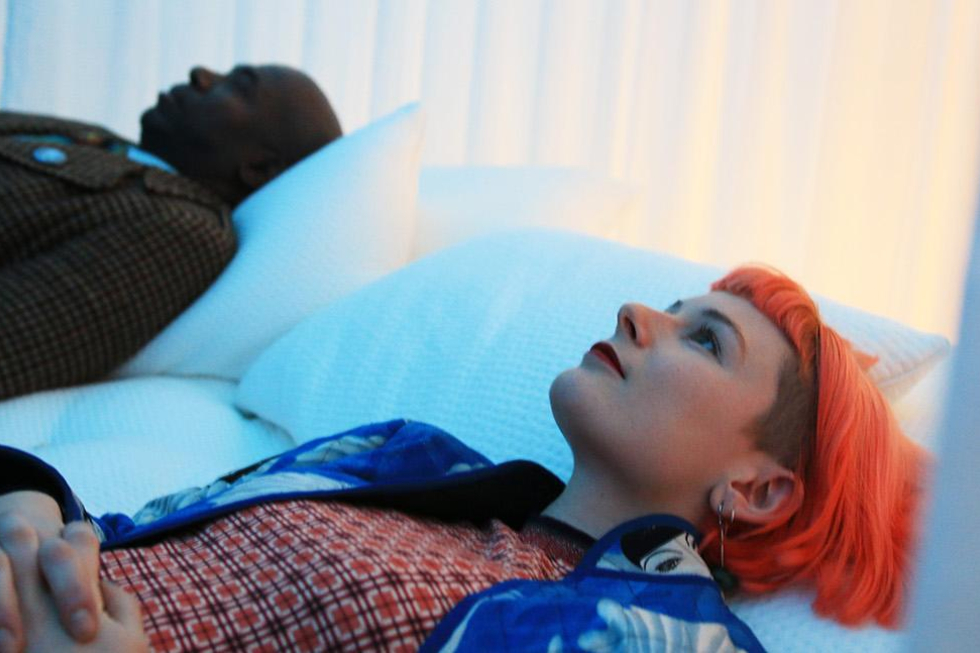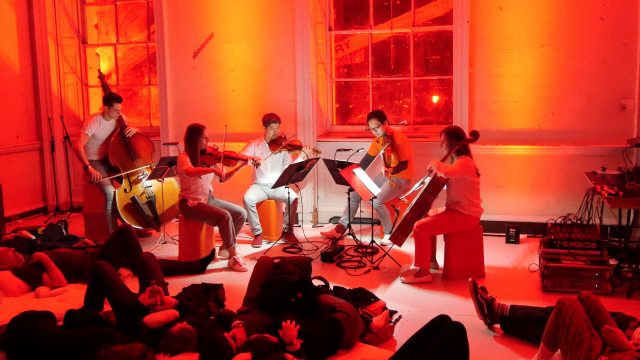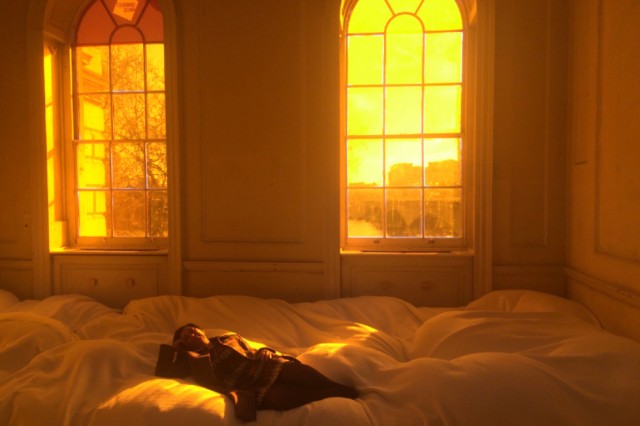Racing Against Time: 24/7 Society & Helga Schmid

“In global lockdown, how we experience time has unexpectedly shifted.” Gabriella Warren-Smith considers her pre-coronavirus experience in Uchronia, artist Helga Schmid’s ‘clockless utopia’…
If I granted you three wishes, what would they be?
I’ve lost count of the number of people who answer: “Bernard’s Watch”. If you’re not familiar with the TV programme, Bernard was the lucky fella in the late 1990s who owned a ‘magic watch’ which could stop and rewind time. In today’s 24/7 non-stop society, the value of time has intensified, and is increasingly considered a luxury. From my – our – position today, in global lockdown, how we experience time has unexpectedly shifted. Our lives are suddenly flooded with those precious hours we’ve all been dreaming of, making it the perfect time – there’s that word again – to consider how we might go about our day, for the present and future.
Such considerations loom large in the work of Helga Schmid, an artist who is fascinated by the misalignment between one’s body clock and the systems of our society. Earlier this year, I interviewed Schmid about her 24 Hours in Uchronia, an event which took place at Somerset House, as part of their 24/7 exhibition programme. Audience members were invited to ‘enter’ her lifestyle model ‘uchronia’, leaving behind their fast-paced lives fuelled by the unholy trinity of technological acceleration, production and efficiency.
A clockless utopia, the event was based on the artist’s PhD research and publication, Uchronia: Designing Time (2020), curated around the natural rhythms of chronobiology (which examines the impact of solar and lunar rhythms on living organisms). It helps explain why certain medication must be taken at night, why leaves drop from trees in autumn, and why birds migrate. It also provides understanding around circadian rhythms, a natural internal process that regulates the sleep-wake cycle which repeats on average every 24.5 hours.

Entering Uchronia, I encountered five thoughtful chambers, in which curated artworks and experiences unfolded, evolving through a 24-hour cycle to reflect one’s body clock at the time. The ‘Movement Phase’ coordinated with a period in the late afternoon where one is most active, with blood pressure and cardiovascular performance at its peak. Here, one could participate in a rhythm singing workshop and observe the flight of a bird in a virtual reality experience. The ‘Concentration Phase’ aligned with the body’s morning peak, characterised by highly functioning short-term memory and logical reasoning. I was invited to listen to lectures on chronobiology and society, making the most of my highly concentrative state.
Schmid said that by planning these transition periods, “you could distance yourself from the busy rhythms of everyday life, giving the time to stop and think in a reflexive manner”. Uchronia is a model of life Schmid lives by. I, however, was new to this. I found it difficult to relax and explored the rooms hungrily in search of action. But as the hours went by, I witnessed the light intensity and mood of the rooms changing with my inner mindset, and began to truly gauge the meaning of this experience. I sunk myself deep into a giant bean bag. Waiting for the curator and artist talk to begin, I observed audience members also relaxing into their experience, sometimes even falling asleep as was secretly intended.
In the digital age, we often use these moments of stillness to tap into our devices. Living with the technological tools which enable us to function with constant (often diminishing) productivity, facilitates a pressure and expectation to be constantly busy. Back in 2011, Sherry Turkle wrote about the tendency for people to seek solace with their personal networks in public places: “being alone can start to seem like a precondition for being together because it is easier to communicate if you can focus, without interruption, on your screen”. In his book Late Capitalism and the Ends of Sleep, Johnathan Crary discusses the increasing integration of one’s time and activity, into the parameters of electronic exchange: “billions of dollars are spent every year researching how to reduce decision-making time, how to eliminate the useless time of reflection and contemplation. This is the form of contemporary progress – the relentless capture and control of experience”.

Whereas Turkle is interested in the social impact of increased screen engagement, Crary is concerned with the driving factor behind this phenomenon: the onslaught of capitalism and the danger it poses to sleep. Although Schmid asserts that “technologies shape and are shaped by society”, she believes that they are neither the problem nor the solution to our non-stop lives. Crary’s view does however support the artist’s central philosophy that time is a social construct, governed by the systems put in place that define the structure of how we work.
I asked Schmid about countries taking positive steps towards work/life balance, suggesting France as an example after they banned after work hour emails. She told me about The B Society in Denmark, an organisation which strives for dual schedules in both the school and workplace, to fit with the two common chronotypes of early and late people. You’ll know right now which chronotype you align with, as it’s down to your state of alertness in the morning. Founder Camilla Kring comments on their central ethos: “I feel that I verbalize a feeling that many B-persons had endured in silence. A feeling of not being accepted and a feeling of duty to give in to the reigning discourse that failure to be out of bed by 6:30 AM and at work by 8 AM were synonymous with laziness… A biological rhythm is not something you choose. You are born with a biological rhythm and the B-Society will fight for chronotype equality”.
It’s true that there are certain connotations associated with sleep, that denounces a person as lazy or unproductive. Rather paradoxically, on the night of Schmid’s event, I had a nightmare in which I overslept and missed the entire Saturday programme, stood up my friend for lunch, and had to make a number of shameful apologies to those I’d let down. There is a certain element of social shaming which comes with sleep and punctuality, whereas one hundred years ago daily napping was a social norm.
I asked Schmid how a ‘late’ person could shift their chronobiological rhythm, as according to her, we are much more in control of our chronotype than we think. Her first suggestion was to stop using an alarm clock. She explained that when late types use these devices, “it means that in the morning period they’re not really awake and are not in a state to start their day”. But it’s not really about the initial waking up, it’s about falling into a continuous cycle which suits your body type, and not relying on the systematic cues which forces us into these patterns.
Far more important is the presence of sunlight. Schmid described how in the urban environment we are mainly indoors, spending an average of only one hour outdoors during the week, and three at the weekend. Even on grey days, outside it’s still 10,000 lux (the unit measuring illuminance) whereas indoors it’s only 500. She went on to explain that with extra sunlight, a late riser could even skip a coffee because of its impact on the body. But with our sustained indoor low light conditions, we are actually more prone to switch into later rhythms and chronotypes. As we are continuously directed into rigid 9–5 working conditions, we also push our bodies into a rhythm outside of our body norm. But as Schmid stresses, “why do we stick to a 9-5 schedule that comes from an agricultural society?” Does the normalisation of these hours really suit the living conditions and individual needs of contemporary humans?
As the world of Bernard and his watch becomes increasingly aligned with our own, the question I’d like you to ask yourself is what will you do with the extra time gained in lockdown? Will you: a) sleep in, take naps, get through that pile of unread books; or b) plunge yourself into that long to-do list and maximise every minute into an opportunity? Either answer is quite telling, as they both allude to this continuously ticking world that we’ve found ourselves in, which either leaves us begging for more time, or drives us into the thought process that we must do more – making a virtue of being too busy! Schmid describes our pre-lockdown lifestyle as a “crazy experiment that we are doing to ourselves”, and questions what we want to gain from the maximisation of time. To cut out thinking periods and moments of stillness, there will be a shift in what we value as a society. Is progress really taking us in the direction we want?
Gabriella Warren-Smith
Main image © Somerset House; additional images courtesy Kevin Walker
Gabriella visited 24 Hours in Uchronia at Somerset House in February 2020





